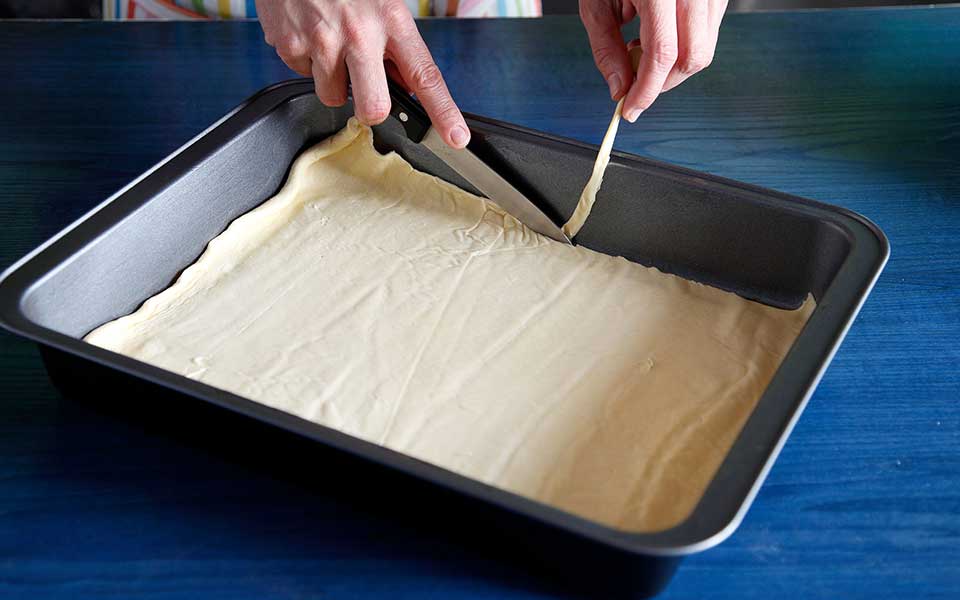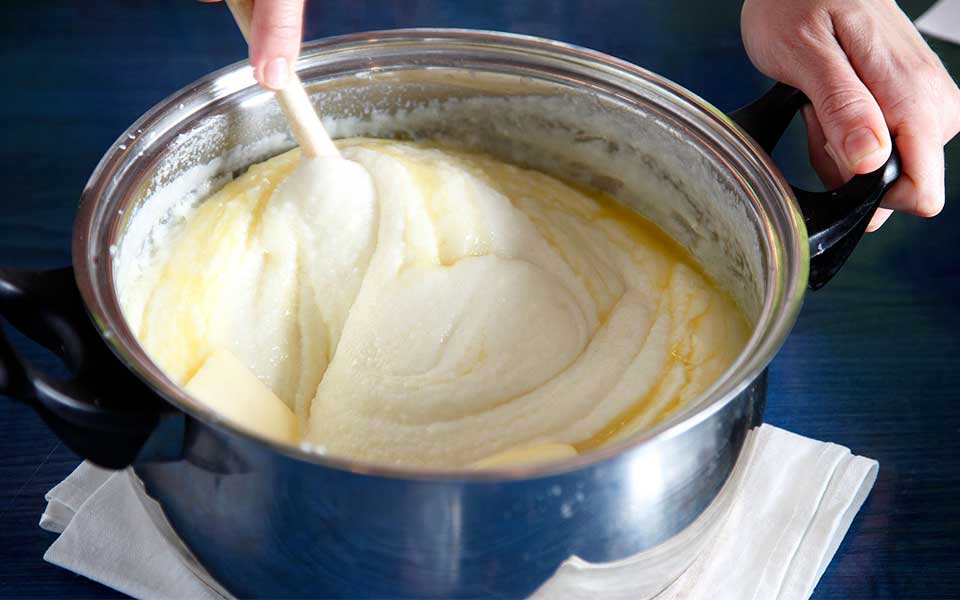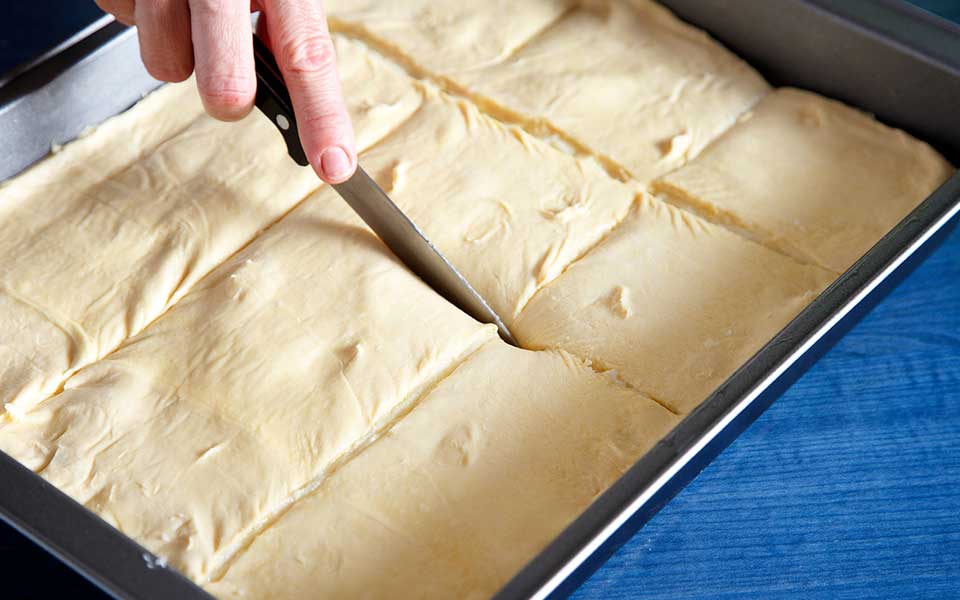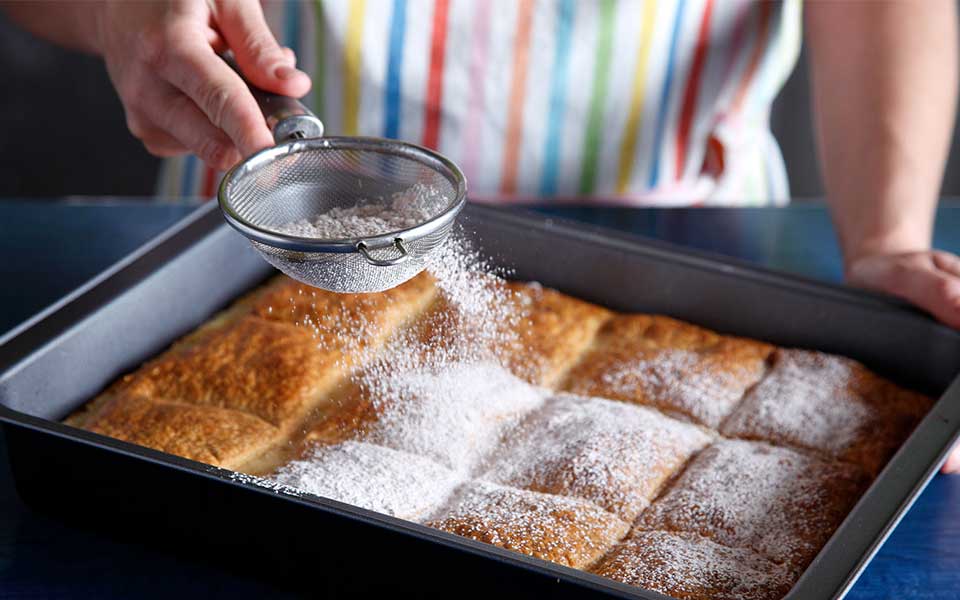From Crete to Serres, on the islands and on the mainland, Greeks and visitors alike enjoy this fluffy, delicious treat brought to these shores from Asia Minor. Wherever you find local producers turning out filo dough, as they do in Rethymno or Iraklio on Crete, or in Ioannina or Thessaloniki (the latter considers bougatsa its own local product), you’ll hear them boast about being the only ones who’ve remained true to the authentic recipe.
Bougatsa is not a pie. Nor is it a dessert, as it may sometimes be described, due to problems in translation. What’s more, if it’s not made with airy, flaky filo pastry, then it shouldn’t be called a bougatsa.
The filo dough used to make bougatsa is not rolled out with a rolling pin; instead, bougatsa makers, true craftspeople, stretch and pull the dough by hand, laying it out on a large work surface. They then open it up like a sheet, spreading it so thin that it becomes almost transparent, as if woven by a spider. They then begin folding it over and over, adding plenty of melted butter as they do so. They also choose the filling. Classic savory fillings include ground meat or herbs and cheese, or just cheese, while the most common sweet filling is a smooth semolina cream. The folding of the dough, combined with plenty of butter, creates parallel layers so the treat is crispy on the outside and soft on the inside.
Below is a very easy version, a variation on the classic recipe, using ready-made thick sfoliata filo sheets because making suitable filo dough from scratch at home is extremely hard. If you want the best possible results, buy the best ingredients: fresh milk from a small farm, ideally organic; eggs from free-range or pasture-fed hens; and fresh cow or sheep butter for a stronger aroma.
Bougatsa is a perfect breakfast or afternoon snack, and will go wonderfully with your tea or coffee.

© Petros Adrianopoulos

© Petros Adrianopoulos
Preparation
Start by buttering a large baking dish.
Next, lay one sheet of filo dough into the dish, carefully cutting it to fit if necessary.
Preheat the oven to 180°C using the conventional oven setting (both heating elements on, top and bottom).
Pour the milk into a saucepan. Add the crystalline sugar and the vanilla pods.
Place the saucepan over medium to high heat. Heat the mixture well until the sugar dissolves completely, stirring occasionally.
Before it comes to a boil, slowly sprinkle in the semolina while stirring. Stir continuously until the mixture thickens into a cream.
Remove from heat and add the 5 tablespoons of butter. Stir until the butter melts and is incorporated into the cream.
Pour the cream onto the filo sheet in the baking dish and spread it out evenly.
Cover with a second sheet of filo dough.
Cut into pieces.
Bake the bougatsa in the oven for 45 minutes.
After taking it out, let it cool for about 30 minutes.
Mix the powdered sugar with the cinnamon. Put the powdered sugar-cinnamon mixture into a small sieve and sprinkle it over the bougatsa before serving.
Ingredients
- 2 ready-made thick sfoliata filo sheets (thawed according to package instructions)
- 1.5 liters of fresh whole milk
- 1.5 cups white crystalline sugar
- 2 vanilla pods
- 1.5 cups fine semolina
- 5 tablespoons butter + 1 tablespoon melted butter for the baking dish
- 5-6 tablespoons powdered sugar
- 1 tablespoon powdered cinnamon

© Petros Adrianopoulos
Helpful tips
Don’t forget to cut the bougatsa before baking, as it’s challenging to cut afterwards!
Be careful; if you try to unfold the filo while it’s still frozen, it may break.
If the cream becomes too thick, add a little milk and stir until it thins down again.
An easy way to place the second filo sheet on top is to leave the plastic backing in place as you put the sheet dough-side down on the cream. Smooth it out and then slowly remove the backing, gently pulling it off.
This article was previously published in Greek at gastronomos.gr.















